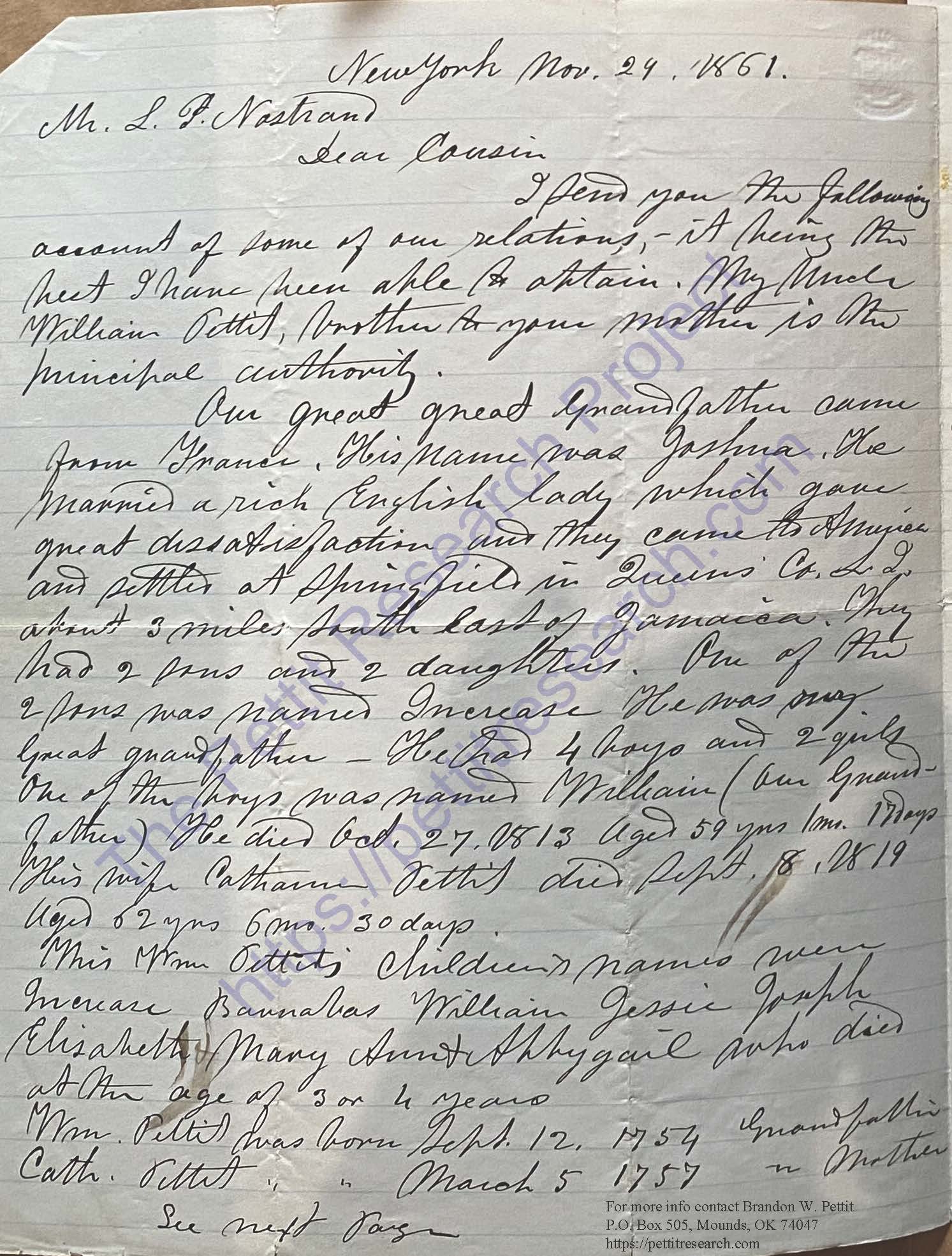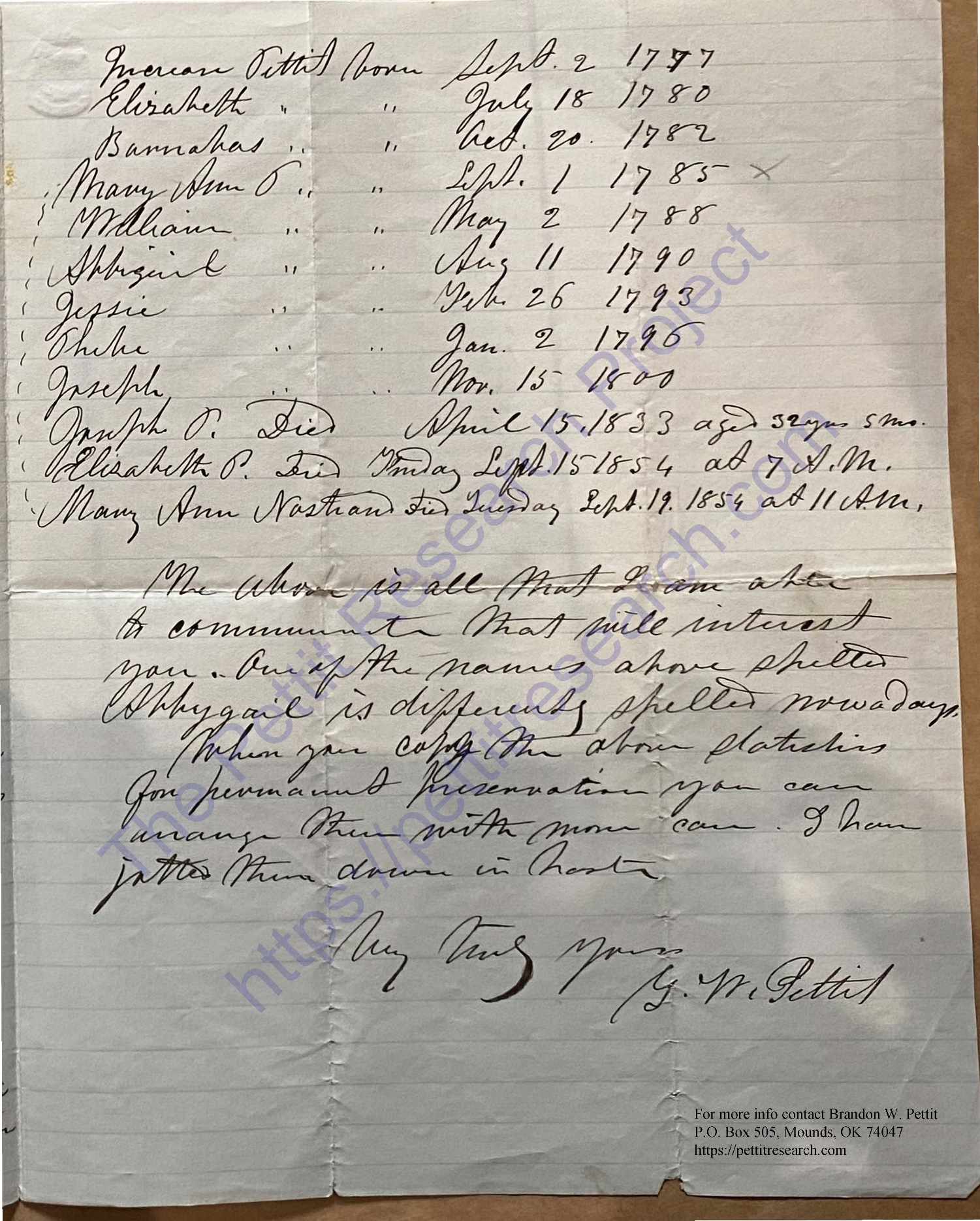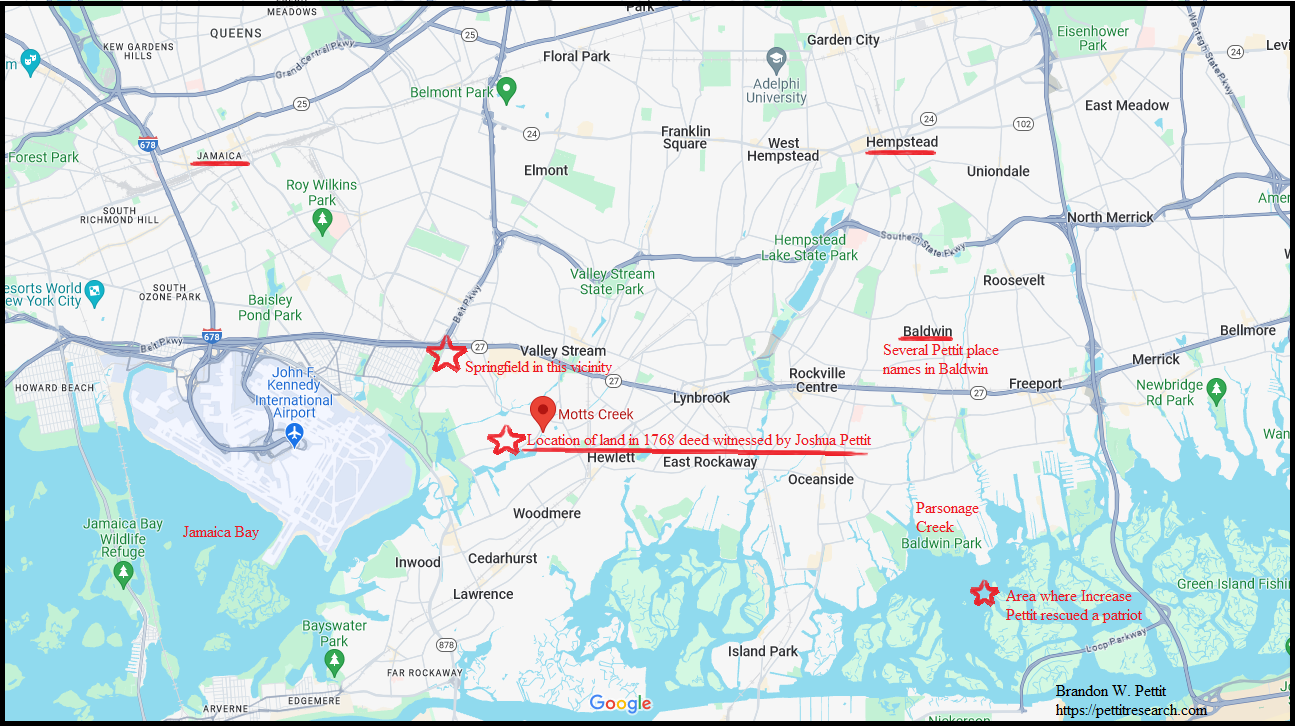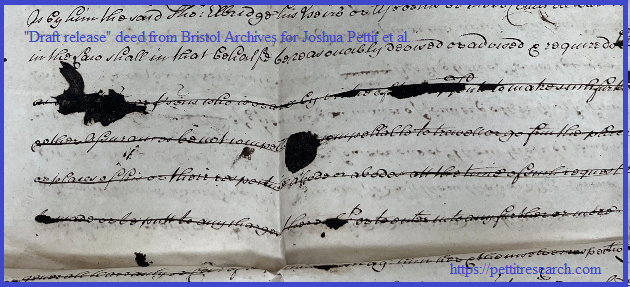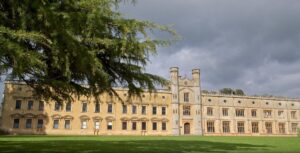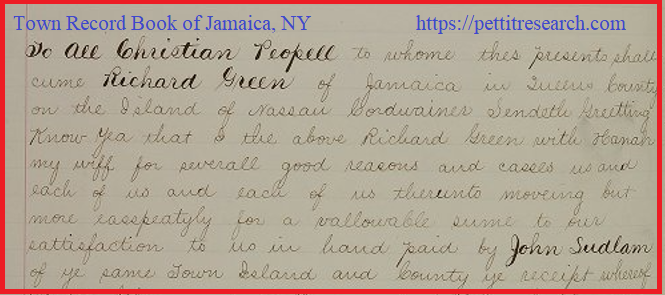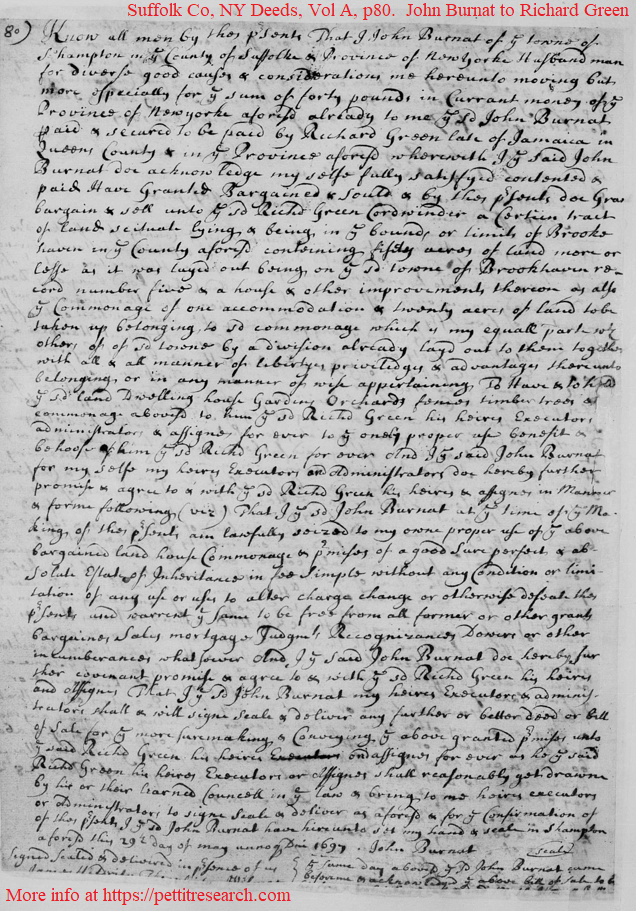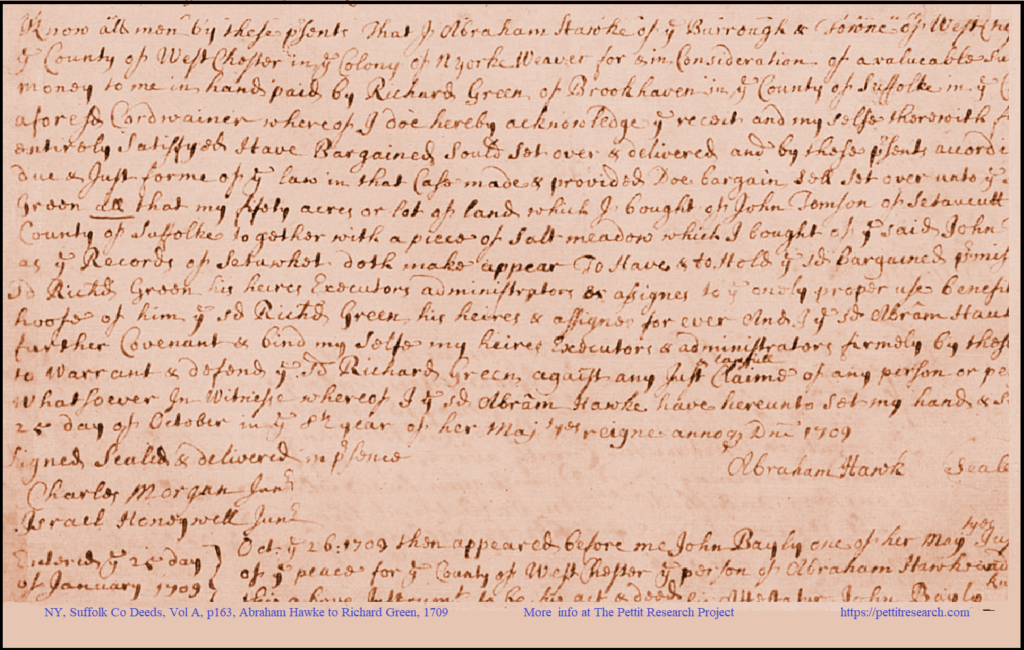Joshua Pettit, Increase Pettit and Martha Greene, a Rich English Lady from Barton Regis to Jamaica, NY
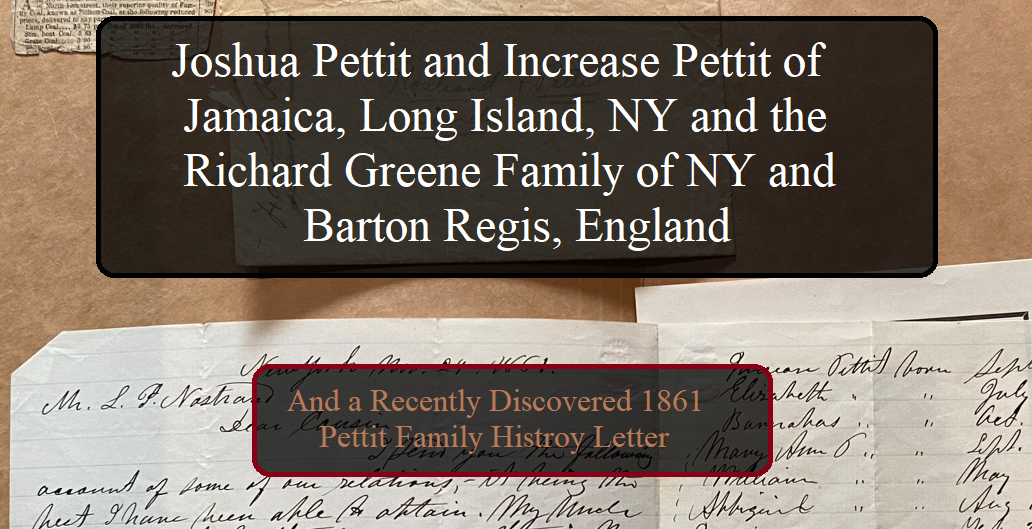
[Click here to download a FREE version of this book in PDF form.]
PREFATORY NOTE
In libraries, universities, and private collections across America shy little records quietly rest, waiting patiently in their dusty homes to be rediscovered. These long forgotten treasures are generally not available online and sometimes not even referenced in any searchable directory. One such precious record was recently discovered tucked away in an unassuming folder labeled “Pettit” at the Brooklyn Public Library. This folder contained a well preserved letter dated November 29, 1861, addressed to Mr. L. P. Nostrand in New York from a G. W. Pettit. The topic of the brief note was the Pettit family history as related to G. W. Pettit by his uncle William Pettit (II) born May 2, 1788. It begins with a man named Joshua Pettit who was from Springfield, Long Island, NY –a little town that was about 3 miles from Jamaica, NY. According to the letter, Joshua was the father of an Increase Pettit who was the father of William Pettit (I) born September 12, 1754.
To date, this is the earliest recorded history of Joshua and Increase Pettit by family successors and the oldest secondary source to allege the father/son connection between these two men. It also captures an old family legend about an English woman which was previously lost to history. In this writing we will examine the Pettit family history and genealogy of Joshua Pettit, Increase Pettit, and William Pettit as put forth in this letter. These brief bits of lore will be compared to the plentiful records of Long Island as well as an obscure deed draft that once belonged to one of Bristol’s most affluent families at Ashton Court.
While every reasonable effort has been made to draw a distinction between fact and speculation in this writing, research does not progress without posing and testing hypotheses. Postulating theories will inevitably trip the novice researcher into passing conjecture along as proven history. New and erroneous legends will be born as a result. Nothing, not even the most direct qualifying language, can completely guard against this damage. Nevertheless, we will move cautiously forward with the understanding that what is presented here needs to be tested, tried, and relentlessly scrutinized before it is shared, copied and warmly welcomed into the gates of family history.
PART I: TRANSCRIPTION OF NOVEMBER 29, 1861, JOSHUA PETTIT GENEALOGY BY G. W. PETTIT
[Page 1][Page 2]New York Nov 29 1861
Mr. L. P. Nostrand
Dear Cousin
I send you the following account of some of our relations, -it being the best I have been able to obtain. My uncle William Pettit, brother to your mother is the principal authority.
Our great great grandfather came from France. His name was Joshua. He married a rich English lady which gave great dissatisfaction and they came to America and settled at Springfield in Queens Co. L.I. about 3 miles south east of Jamaica. They had 2 sons and 2 daughters. One of the 2 sons was named Increase. He was my great grandfather. He had 4 boys and 2 girls one of the boys was named William (our grandfather) He died Oct 27, 1813 aged 59 yrs 1 mo 17days. His wife Catherine Pettit died Sept. 8, 1819 aged 62 yrs 6 mo. 30 days.
This William Pettits children’s named were Increase Barnabas William Jesse Joseph Elizabeth Mary Ann & Abbygail who died at the age of 3 or 4 years.
Wm. Pettit was born Sept. 12, 1754 grandfather
Cath. Pettit ” ” March 5, 1757 ” mother
See next page
Increase Pettit born Sept 2 1777
Elizabeth ” ” July 18 1780
Barnabas ” ” Oct 20 1782
Mary Ann P ” ” Sept 1 1785
William ” ” May 2 1788
Abbygail ” ” Aug 11 1790
Jessie ” ” Feb 26 1793
Phebe ” ” Jan 2 1796
Joseph ” ” Nov 15 1800
Joseph P. died April 15, 1833 aged 32 yrs 5 mo
Elizabeth P died Friday[?] Sept 15 1854 at 7 A.M.
Mary Ann Nostrand died Tuesday Sep 19, 1854 at 11 A.M.
The above is all that I am able to comment that will interest you. One of the names above spelled Abbygail is different spelled nowadays. When you copy the above statistics for permanent preservation you can arrange them with more care. I have jotted them down in haste.
Very Truly Yours,
G. W. Pettit.
PART II: IMAGES OF THE 1861 LETTER
PART III: EXAMINING THE LETTER
The author signed his name as G. W. Pettit.
There is another letter found in this same folder that revealed what the “G” stood for. That letter is primarily about the Nostrand family and has not been included here but the pertinent part states:
Dear Brother, When you was here you had a pedigree of the family furnished you by George Petit [sic]…
Thus, we can safely say this letter was penned by a man named George W. Pettit. The recipient of the letter, as seen at the top of the original page, was Mr. L. P. Nostrand. Also in the folder is a small loose obituary clipping from an 1850’s newspaper. It states:
“DIED. On Thursday morning July 1st, Lewis Pease, aged 8 months and 8 days, twin child of Lewis P. and Elizabeth R. Nostrand.”
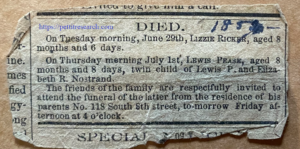
1850s Obituary for L. P. Nostrand (infant)
This little 8-month-old twin child that perished, Lewis Pease Nostrand, was apparently named after his father Lewis P. Nostrand. Though the familial connection is not abundantly clear from this obituary, it appears the recipient of George W. Pettit’s letter, Mr. L. P. Nostrand, was named Lewis Pease Nostrand. Thus, it can be said that the 1861 Pettit genealogy letter was written by George W. Pettit to Lewis Pease Nostrand. Next, we must determine how these men relate to one another and what their connection was to Joshua Pettit and Increase Pettit.
According to the letter by George W. Pettit, Mr. Nostrand was the son of a Mary Ann Pettit. He and George W. Pettit shared a common uncle named William Pettit. They also shared another William Pettit as a grandfather. Increase Pettit was said to be their great grandfather and Joshua Pettit their great great grandfather. Without going outside of this letter to other sources we can sketch out the following tree based strictly on the limited information provided.
Family Tree Based on the 1861 Pettit Letter
1st Generation: Joshua Pettit +m “rich English lady”
2nd Generation: Increase Pettit (also had one brother and two sisters)
3rd Generation: William Pettit (I) Sep 12, 1754 – Oct 27, 1813 +m Catherine Pettit Mar 5, 1757 – Sept 8, 1819
4th Generation:
- Increase Pettit born Sept 2, 1777
- Elizabeth Pettit July 18, 1780 – Sept 15, 1854 [Mother of author, G. W. Pettit]
- Barnabas Pettit Oct 20, 1782
- Mary Ann Pettit Sept 1, 1785 – Sep 19, 1859 +m Mr. Nostrand
- 5th Generation: Lewis Pease Nostrand [recipient of the letter]
- William Pettit May 2, 1788 [uncle to the author, G. W. Pettit]
- Abbygail Aug 11, 1790 – died aged 3 or 4
- Jessie Pettit Feb 26, 1793
- Phebe Pettit Jan 2, 1796
- Joseph Pettit Nov 15, 1800- Apr 15, 1833
L.P. Nostrand was the son of Mary Ann Pettit. One would think that, because his last name was Pettit, George W. Pettit would not be the son of one of the Pettit women whose name would have changed when they were married. However, we find that 4th generation Elizabeth Pettit (1780-1854) married a William Pettit (1776-1853) who was probably from the unrelated Pettits of Hempstead on July 28, 1799. [1a] When William Pettit married Elizabeth Pettit her surname did not change and her son was, therefore, named George W. Pettit. George W. Pettit’s grave is next to that of his father and mother in Greenfield Cemetery, Uniondale, New York.[1b]
It is also important to point out that “1st generation” Joshua Pettit had two sons and two daughters according to the letter. None of the names of his children were given except for Increase Pettit. Some have speculated that the other son may have been named Joshua II born in 1734 who relocated to New Jersey, Virginia and South Carolina in that order. There are also some who claim the other son was a man named Zadok Pettit. While either relationship is theoretically possible it also may have been neither. At the very least we know, according to this letter, that it could not have been both.
However, the amount of weight we give this old writing depends largely on the sources employed by George W. Pettit. One such source cited by the author was “Uncle William Pettit.” Uncle William was the William Pettit born May 2, 1788. He was the son of William Pettit (I) who lived until the 24th year of William (II)’s life. Uncle William was said to have been the “principal authority” behind the information provided to George W. Pettit for the letter. Uncle William Pettit was the great grandson of the old Joshua Pettit who was said to have immigrated from France to England and then to Springfield, Long Island, NY. The manner in which the family history was passed to Uncle William Pettit is not known and we therefore do not know how close he was to the origin of these stories.
Without deviating into a wearisome technical discussion on sources and evidence, it will suffice to say that the letter is a complex blend of firsthand, second hand, and third hand information. Care should be taken when evaluating the statements made in the letter to determine if they are primary, secondary or tertiary sources. It can get tricky with this kind of evidence and we must be cautious with our conclusions. “Old” history does not necessarily mean “correct” history, especially if it is passed from generation to generation as a verbal tradition. In the instant case, however, there are some slight clues that at least part of the information may have been derived from a written record.
Copied from a Family Bible?
Anyone who has experience with old family Bibles records may notice a curiously familiar structure to some of the information found in this letter. It is common for both gravestones and Bibles to reference the date of death and sometimes list the final age down to the number of days. We see this format used in the letter where it was stated that Joseph “died April 15, 1833 aged 32 yrs 5 mo.” However, one thing that is not usually seen on gravestones that is almost exclusive to Bible records is the time of vital statistics. Note in the letter that Elizabeth Pettit was said to have “died Friday Sept 15, 1854 at 7 A.M.” A similar entry is found for Mary Ann Pettit Nostrand who died “at 11 A.M.”
This level of specificity down to the hour of death is often found written on the “deaths” page of family Bibles. Though it is impossible to know for sure from the evidence before us, it does appear that George W. Pettit copied this information from a source that suspiciously resembled a typical family Bible record. He may have had such a Bible in his possession since he was apparently fulfilling the role of the family historian. His knowledge of the family is surely what prompted Mr. Nostrand to contact him.
Purpose of the Letter
Obviously, the letter was in response to some questions about the Pettit family that Mr. Nostrand had for George Pettit. However, there is evidence there may have been a broader purpose than mere curiosity. George W. Pettit, the author, stated:
When you copy the above statistics for permanent preservation you can arrange them with more care.
What kind of “permanent preservation” had Mr. Nostrand devised? In addition to the Pettit file described here, the Brooklyn Public Library contains a family file on the Nostrand family as well. They have other material collected by Lewis Pease Nostrand. Evidently, he was engaged in serious genealogy work. He may have also been involved in one of the early history or genealogical societies in New York. Perhaps with further exploration of the Nostrand family files the “permanent preservation” he was working on could be discovered. More Pettit history could possibly be nudged out of hiding. Family legends and lore, though sometimes deceptively inaccurate, are also sometimes rooted in truth. They should not be dismissed until thoroughly tested.
Pettit Family Legends From the Past
This French origin family legend can be found in most American Pettit clans including those descendants of early immigrant John Pettit of Connecticut and the unrelated[1] Thomas Pettit of Boston. The Pettit Research Project[2] has conducted surveys of Pettit descendants for many years. One of the questions asked is, “Setting aside what you now know about your ancestors, what old stories were passed down to you about their origins?” A large majority of those who respond claim to have been told the Pettits came to America from France. Indeed, this story was what was handed down to this researcher by his father and in this branch we were even told a specific region in France: Alsace-Lorraine. Regardless of the feasibility of this legend it has shown itself to be both widespread and relatively ancient in origin. There is a letter from 1936 in which this was discussed between Pettit cousins who were descendants of Joshua Pettit of Spartanburg Co., SC.[3] The discovery of this 1861 letter pushes the origins of this story back another 75 years.
However, it should be noted that, according to respected DNA experts, this lore does not comport at all with the current Y-DNA data on the Pettit family. Be that as it may, for the purpose of analyzing this record, we will take all the 1861 claims at face value so we can make sense of the story as a whole and try them for accuracy. The French story is only a small component of the narrative.
Consider what else is implied from the following statement found at the beginning of the letter:
Our great great grandfather came from France. His name was Joshua. He married a rich English lady which gave great dissatisfaction and they came to America and settled at Springfield in Queens Co. L.I. about 3 miles south east of Jamaica.
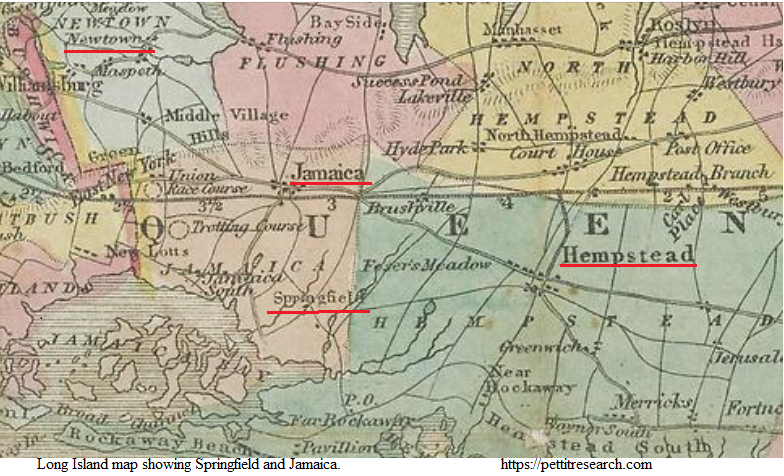
Long Island map showing Newtown, Jamaica, Springfield, and Hempstead
Joshua Pettit was said to have been a resident of Springfield in the 1861 letter. This Springfield was also said to be about 3 miles southeast of Jamaica. Pettits are found in this time period in the town records of Jamaica, Hempstead and Newtown. All these towns were within about 10 miles or less from each other. Springfield has since been absorbed by the surrounding metropolis but can be seen as a distinct location near Jamaica Bay on older maps.
Springfield was indeed “about 3 miles southeast of Jamaica” as the author of the 1861 letter declared. It appears within the jurisdictional boundaries of the Jamaica township so that is likely why Joshua Pettit is also said to be from Jamaica in other records. In one sense he was, but he was also from Springfield. When someone was identified as a resident of a particular New York township, they may have lived at the actual seat of the town or simply within the limits of the township’s authority. One is more specific than the other.
Also, according to George W. Pettit who probably received this story from William Pettit (I), there was a young Joshua Pettit who migrated from France to England after he married a rich English woman. This gave “great dissatisfaction” to someone, perhaps her wealthy family. Marriage outside of one’s social class could be destructive to the objective of amassing property –a top priority for the affluent. As a result of the unsatisfactory arrangement, the family moved from England to Springfield, Long Island, New York. Could such an amazing tale be grounded in truth? The answer to this question may be found if the identity of the mysterious “rich English lady” could be discovered. Was that unnamed woman Susanna Carpenter, the woman commonly thought to be his wife, or perhaps some other fair maiden?
PART IV: THE 1725 DRAFT DEED IN BRISTOL ENGLAND
Susana Carpenter
For years there has been debate among researchers as to whether Joshua Pettit of Jamaica married Susannah Carpenter, daughter of John Carpenter or a woman named Martha Green/Greene.[4] While consideration could be given to the possibility that he may have married both, the evidence for the marriage to Susannah Carpenter appears to be purely circumstantial at this time. The justification for this theory goes something like this: “From the will of John Carpenter we learn that he had a son named Increase Carpenter. Joshua Pettit witnessed a will along with Joshua and William Carpenter. Joshua Pettit also named his son Increase. Increase is such a rare name that it is assumed Joshua did this in honor of his wife’s brother. Thus, according to the theory, Joshua Pettit married Susannah Carpenter, sister of Increase Carpenter.” There is no intention to put forth a straw man here, but if there is a better case for the supposed marriage to Susannah Carpenter, it remains to be seen.[5]
About the Name Increase
Briefly addressing the logic behind this theory demands a peak at the unusual forename Increase. Increase may seem like a unique name today. However, in the 17th and 18th century it was much more prevalent, especially among Puritans in New England. Aside from being a given name, Increase/Encrease was also the name of a British ship which brought many colonists to the New World.[6]
The name is derived from the Hebrew word for Joseph. Yosef in Hebrew means “he will add or increase”.[7] It is transliterated as “Joseph” in English but the literal meaning of the name is “increase.” The name was never extremely common but was in moderate use for a brief time. Increase Mather (1639-1723), a well-known Massachusetts Puritan, president of Harvard University and politician, may have been the namesake for many unrelated colonists.[8] By the time of the first census of the United States in 1790 there were still over 50 men scattered around the United States who were heads of household with that name. There is no reason to assume a correlation between two people who had this given name. It is also possible Increase Carpenter and Increase Pettit were related, but proof is lacking to make that conclusion.
Martha Green, Wife of Joshua Pettit
The marriage of Joshua Pettit to a Martha Green, on the other hand, has long been confirmed by at least one reliable contemporaneous source. That source is not found on Long Island or even in America. It is located in the National Archives in Bristol, England. [9] It is a “draft release” and involves several parties on opposites sides of the Atlantic Ocean. The Bristol National Archives expertly summarized the core facts of the draft deed of release as such:
Elizabeth Greene of the town of Jamaica, Queens County, Island of Nassaw, New York, widow of Richard Greene of Barton Regis, ropemaker, and sole heiress of Jonathan Edwards of Bristol, haulier; Richard her son; Joshua Pettit of Jamaica town, yeo. and Martha his wife, (née Greene).
The record is dated April 2, 1725, and consists of 10 somewhat messy pages. As a “draft release” deed the document contains no signatures and was not the official transaction. It has several lines of struck-through text with corrective language inserted. It is clear this “draft” deed was just that, a rough draft.
In the archival title it was noted that the lease was “missing.” What this means is the draft deed was only the “release” half of a “lease and release”.[10] Fortunately, the bulk of important genealogy matter is usually duplicated in the release portion of a lease and release, so this missing lease is not a significant hindrance to research. The final deed, if found, may disclose a few additional clues but there is plenty of information in this draft to be evaluated.
From the draft deed the extended family of Joshua Pettit and Martha Green can be constructed. The Bristol Archives summary report does not elaborate on the nature of some of the relationships. For instance, Elizabeth Green was the heir of a Jonathan Edwards but how was she related to him? The answer to this question and others is made clear in the 10-page document itself which reveals, among other things, that Elizabeth Green was the daughter of Jonathan Edwards Sr. Below is a family tree constructed exclusively from the information provided in the text of the deed without using any outside sources. It should be used as a reference for the rest of this writing.
Pettit, Greene, and Edwards Family Tree Based on 1725 Draft Deed
(Note: The suffixes “elder” and “younger” do appear in the original document in reference to the two Jonathan Edwards but not in reference to the two Richard Greens, though the document does declare the father/son relationship between the Richard Greens. The terms “Sr” and “Jr” will, therefore, be used in this writing for all parties so they can be easily distinguished.)
1. Jonathan EDWARDS Sr
1. Jonathan EDWARDS Jr
2. Elizabeth EDWARDS +m Richard GREEN Sr
1. Martha GREEN +m Joshua PETTIT
2. Richard GREEN Jr
3. Mary EDWARDS +m William PROSSOR
Martha Greene, Rich English Lady
As indicated, Martha Green married Joshua Pettit. Martha’s mother Elizabeth Green was the daughter of Jonathan Edwards Sr and sister to Jonathan Edwards Jr. In his lifetime, Jonathan Edwards Sr purchased several properties from a Baron named Walter Lord Aston, the heir of Ralph Sadleir, Esquire. Much has been written on both of these men and it would not be prudent to diverge into their extensive history here. George W. Pettit, in his 1861 letter, did not elaborate about the nature or origin of the wealth of Joshua Pettit’s unidentified wife but this draft deed lends some credence to that story. A review of the lands that Elizabeth Edwards Green had inherited does suggest that a respectable fortune had indeed passed to her. The land to be deeded is described on page three of the draft deed where it states:
All that one Moiety or half part the same being considered as divided into two equal parts of all that messuage or house with the yards gardens and orchards thereunto [being]… all that part or parcel of ground called or known by the name of Downend by est two acres and one half (be it more or less) and also…the Marshleaze and Townsend containing by est four acres (be it more or less) and also… the Paddock…containing by estimation one acre (be it more or less) and also… the Great Oare and Little Oare containing by est seven acres (be it more or less) and also of common for thirty sheep…
Elizabeth and her offspring inherited what the draft deed calls a “moiety of messuage and closure” of several places around Bristol, England. These curious terms were more commonly used in England than in colonial America and their meaning is important. A closure simply denotes land that has been enclosed by a fence, hedge or wall. This distinction was made because the expense of fencing boosted the value of the property and was an important feature for sheep herders. A messuage meant that the land had a dwelling house. A moiety was a half interest in an equal part of a piece of real property. Taken together these words imply that Elizabeth Edwards Green had inherited a half interest in several lands, most of which were fenced and included at least one home. Also inherited were rights to commonly held pastureland that was good for 30 sheep.
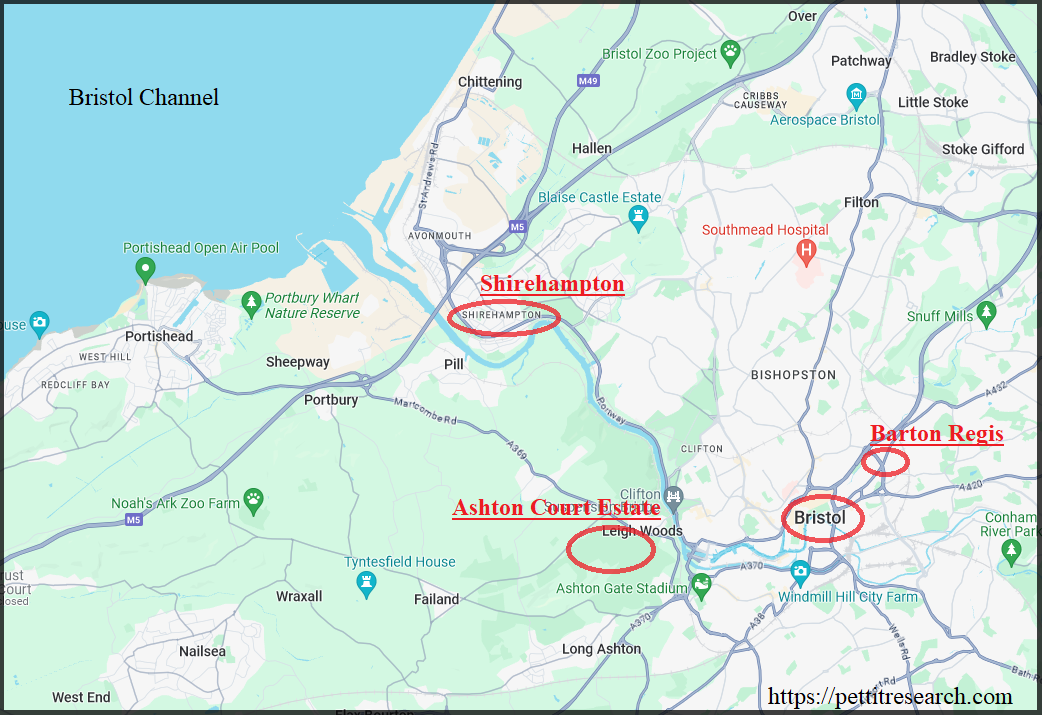
Modern map of location of English lands inherited by the Greene family and other sites of interest near Bristol, England
Heir to English Lands Near Bristol
The location of these estates was in and around Shirehampton on the north side of the Avon River and within about a mile’s distance from the busy wharf at Bristol. This property was also about 2 miles northeast of a wealthy family’s home called Ashton Court. Before acquisition by the archives, the draft deed was privately held, along with numerous other records, by the Smyth family of the Ashton Court Estate.[11] The Ashton manor was (and is) a large mansion located southwest of Bristol.[12] The draft deed in particular was in the sub-collection under the Ashton Court Estate records marked for the Elbridge family estate. The Smyth family of Ashton Court Estate had married into the Elbridge family, combining the vast land holdings of both families. The Bristol Archives described the merged records of both families in the following way:
These sub-series consist of records brought into the Smyth family as a result of marriage. A succession of judicious marriages in the late 17th and 18th centuries increased the estates and wealth of the Smyth family very considerably. In each case the marriage brought into the family not only a sizeable inheritance in land, but also the documents relating to the lands concerned.
The property that Elizabeth Edwards Green had one-half interest in was to be sold to the Elbridge family in the 1725 draft deed for £245 New York money. To convert this currency directly into today’s money is a virtually impossible task due to enumerable factors that are outside the scope of this study.[13] Perhaps the quickest way to put this purchase price in perspective though is to consider that by the close of the colonial period, the average American annual income has been estimated to be about £14.[14]
A person possessing roughly 18 times this amount would have probably been considered “rich” by most yeomen in a farming community like Jamaica. So would a local Long Island family who held an equal half-interest in several estates back in Bristol, England that were shared with the renowned Ashton Court. In light of this, there is reason to believe the story of the “rich English lady” who married Joshua Pettit may have originated with the Green family’s fortune or, at the very least, with their dealings with the Elbridge family and the extremely prosperous Ashton Court Estate. Joshua Pettit’s marriage to Martha Green entitled him to a portion of this legacy.
Joshua Pettit of Long Island has been the subject of a genealogical manhunt for decades. The information available on him has been widely circulated among researchers but has been limited to the Pettit and Carpenter families. The Green family, however, has slipped by unnoticed without any serious attempt to document their movements and history. By studying this little family, we may gain a better understanding of the Pettit family they associated with.
PART V: THE RICHARD GREENE FAMILY FROM BARTON REGIS, ENGLAND TO NEW YORK
Richard Green, the senior, lived in Barton Regis, Gloucester County, England. This ancient settlement is listed as far back as AD 1086 in the Doomsday Book and was very near Bristol in the 17th century.[15] Richard was a “ropemaker”. In Richard’s day, the development of mass production of ships had increased the demand for seafaring goods and labor including ropes and ropemakers.[16] Bristol, a large and active seaport adjacent to Barton Regis, would have been a good place to make and sell his products.
Richard married Elizabeth Edwards and had two children, Richard Jr and Martha. Elizabeth was the daughter of Jonathan Edwards who was from Bristol. His occupation and social standing were not disclosed in the draft deed but his purchase of several valuable lands suggests some economic prosperity. Though far from conclusive, there is evidence that suggests Richard Green Sr, moved to the busy colonial seaport at New York City before dying sometime before 1710, leaving his widow Elizabeth there. The record is much clearer regarding his widow and children’s location in 1725. In that year his widow, son Richard Jr, and daughter Martha were recorded as residents of Jamaica, Long Island, New York in the draft deed.
Martha Green married Joshua Pettit sometime before the draft deed was written but it provides no hint about where this marriage occurred. The 1861 George Pettit family history letter implies that the marriage took place in England and “caused great dissatisfaction” which prompted them to leave for the new world. This would seem to be at odds with more recently constructed family genealogy which show this Joshua as a descendant of Thomas Pettit who was already in Boston in the 1630s.
Stepping outside the draft deed and looking at colonial American sources, a detailed timeline of events can be constructed. At least two and possibly three distinct men known as Richard Green are found in a handful of New York records. The movements of these men will be tracked and ties between them will be carefully considered. It cannot be emphasized enough that the evidence of these connections is not conclusive. It is presented here merely as a research aid with the hope of outlining the known facts in a usable, easy to reference collection.
Timeline of Events
1693
A land deed found in one of the old record books of the Queens County, New York reveals at least one Richard Green had been living in the colony since before October 23, 1693.[17] On that date Richard “Greene” of Hempstead purchased from Richard Rhoades of Pessankin, Philadelphia eight acres excepting “the land that was formerly given unto John Rhoades by his father Richard Rhoads.” The deed was witnessed by Daniel Whitehead and Samuel Ruscoe. On November 8, 1694, the deed was entered into the books in Jamaica where Richard Rhoads and his wife attested to its veracity in front of Daniel Whitehead, Justice of the Peace. Since this Richard Green was said to be “of Hempstead” he had already taken up residence in Queens County at an earlier date. There is reason to believe his former residence was Flushing as noted later in a later 1695 deed which will be disclosed shortly. The Rhoades family will appear in other documents alongside the Green and Pettit families as well.
1694
On June 23, 1694, Richard “Greene”, Joseph Hedges, James Clement, witnessed the sale of 7 ½ acres of land in Jamaica on “further east neck” bordering the bay.[18] Waite Smith and Phebe Smith, his wife, sold the tract to John Talman of Flushing.
1695
On March 11, 1695, Richard Green is mentioned in a land deed between James Harde of Flushing who was said to be now living in New Haven, Connecticut, and John Esmond of Flushing.[19] The land was located near Mattagarrison bay[20] within the bounds of Flushing “with all ye housing standing there upon which was formerly Richd. Greens”. Other neighbors included Joseph Heaviland and Joseph Tindall. The deed was witnessed by James Clement and Edward Burrows and was recorded in front of Thomas Hicks on August 11, 1695. According to the description of the property, Richard Green had resided north of Hempstead in Flushing for a time but had relocated by 1695. The earlier deed placed him in Hempstead in 1693 meaning his time spent at the home at Flushing preceded this.
Another deed in the Jamaica town record books from November 13, 1695, unveils more useful details about this Richard Green.[21] That deed states:
To all Christian people to whom these presents shall come Richard Green of Jamaica in Queens County of the Island of Nassau cordwainer sendeth greeting Know yea that I the above Richard Green with Hannah my wife…
There is no reason to suspect this was Richard Green Sr. of Barton Regis, England because the record gives the name of his wife –and it wasn’t Elizabeth. This Richard Green’s wife’s name was Hannah. The Richard Green in this November 1695 deed was also said to be a “cordwainer” meaning he was a leather boot maker by trade, not a ropemaker as in the 1725 draft deed. This deed also disclosed the location of Richard’s home in 1695, given as Jamaica, NY –probably a reference to the general township and not the town proper. The portion of land he owned was sold in this deed to John Ludlam. It was said to be near “the swimming pond” but “excepting the part of the home lot at the rear.” The transaction does not specify the purchase price but does state that Richard and Hannah received “a valuable sum to our satisfaction to us in hand.”
Richard retained a portion of this property but sold that to Daniel Whitehead a month later on December 20, 1695.[22] In this transaction he sold the “remaining place of my house lott excepting what is sold to John Ludlam” and also “ye bitt of land given to John Boodes (Rhoades?) also excepted.” This deed was not recorded until many years later on May 9, 1706, by S. Clows, town clerk. Disposing of his Jamaica property may have been in preparation for a move to a different town much further east as will be seen in a moment.
Also, from 1695 to 1699 a distinctly different Richard Green is listed as living in the South Ward of New York City.[23] This small detail will be more important later.
1696
In 1696, in Jamaica, NY, a Richard Green and Samuel Ruscoe witnessed the sale of land from John Freeman to Joseph Pleas.[24] This involved a lot formerly owned by Edward Higbee of Jamaica bounded east by John Roads (Rhodes), west by John Everitt, north “by highway running as also bounded with John Roads only a highway run betwixt the above John Roads & John Everitt to ye sdd lott.”
Samuel Ruscoe was a clerk and his name appears frequently throughout these Jamaica records until about 1696. An interesting fact is that a 5-year-old Samuel Rusco came with his family to Massachusetts Bay on a ship which set sail from London in April of 1635. That ship’s name was the Increase.[25]
John Roads is very likely the “John Roods” whose last will and testament was witnessed by a Joshua Pettit some years later. He is also possibly the same John Rhodes in the 1693 Hempstead deed witnessed by Richard Green.
1697
After selling the Jamaica property, there is strong evidence this Richard Green appeared on record in the town of Brookhaven over 40 miles away on the east side of Long Island.[26] On May 29, 1697, John Burnat (elsewhere Burnett, Burnit) of “Southampton county of Suffolk and province of New Yorke husbandman” sold a tract of land to Richard Green for £40 New York money.[27] According to the deed, this Richard Green was a cordwainer from Jamaica. With this deal Richard amassed 50 acres of land in Brookhaven which was said to have been laid out in “Brookhaven record number five”.
In the same record he also purchased Mr. Burnat’s rights to 20 acres of “commonage” which was a jointly owned pasture for livestock grazing shared between landowners under Brookhaven’s township authority. Unfortunately, the names of witnesses on this deed were so near the bottom of the page that they have been obliterated by the sands of time. They would have likely been Brookhaven residents and possibly neighbors.
Just two days prior to this Brookhaven transaction, on May 27, 1697, Richard Green was mentioned in a deed as the former occupant of an “orchard home lott of land and lot of meadow within the bounds of Jamaica”.[28]
This deed was between William Nicoll of New York City and Samuel Mills of Jamaica. It was witnessed by Thomas Waters, Thomas Foster, and Samuell Mills. It was recorded by Andrew Gibb, the Suffolk County Clerk also called the “Suffolk Attorney and Commissioner.” Gibb was listed as the principal grantor on the deed who was acting on behalf of Mr. Nicoll and had received “certain commission and general letter of attorney for and in consideration of the sum of 40 pounds.” It was sworn to before Daniel Whitehead the Justice. The fact that this deed mentioning Richard Green as the former owner of the Jamaica land, and it came just two days after his purchase of land in Brookhaven cannot be overlooked.
A few months later, on June 5, 1697, Richard Green, John Thomas, and Hannah Huls witnessed a will of Peter Whitehair of Brookhaven.[29] In this will, Peter left his son Abram Whitehair a 50-acre lot bounded by Andrew Miller, John Woods, and John Muncye.
1699
A couple years later, on October 2, 1699, Richard “Greene”, William Creed Junor, Samuel Ruscoe and Isaac Semon (Seaman), witnessed a transaction between William Creed and Sarah Creed of Jamaica and Doctor Robert Read of Jamaica. [30] About nine acres of land in Jamaica was sold that was bounded by Henry Filkin, James Hadlick, Jonathan Wood, Richard Oldfield, and Captain Daniell Whitehad and by the street leading to New York City.
1702
Meanwhile, across from the western shore of Long Island, on Manhattan Island, another Richard Green was completing a tour of military service. Unlike the man living in Brookhaven, there is reason to suspect this man may have been Richard Green Sr from Barton Regis. In New York City on May 30, 1702, it was noted that “Richard Green, Ropemaker” along with several other men who had been used as soldiers guarding New York City in Queen Ann’s War were granted freemen status.[31]
The persons hereafter named were made freemen of this corporation by order of the common council yesterday made, they being the Officers and Soldiers of his Majesty’s Garrison at Fort William Henry in this city.
The Fort William Henry referred to was just north of the South Ward in New York City.[32]
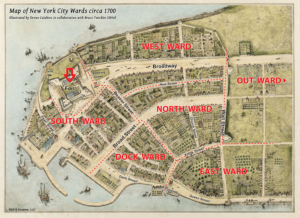
Original image courtesy of “Saving New York”. https://www.savingny.com/maps1695.html
The “order of the common council” referred to a generous decision by the council proposed on May 12, 1702, which granted “freemen” status to those men who had been sent to the colonies and served as soldiers in protection of the citizens of New York City. The term “freemen” does not mean they were previously enslaved. On the contrary, the council recognized that many of them were skilled tradesmen who were not able to make an adequate living strictly as soldiers. By granting them “freeman” status, they were able to take advantage of all the rights and privileges of a citizen of New York City. The council explained their rationale in the following manner:
Whereas, His most sacred Majesty among many other princely favours shown to this Province, hath sent over during the Late Warr a Considerable number of forces to protect and secure us from the Insults of our Enemies the French of Canada and their Indians, which forces for our further protection his Majesty has been graciously pleased to continue amongst us.
And Whereas, All manner of Provisions and Apparell are much dearer in this Citty than in England whereby the said soldiers Cannot Convenienly subsist of their pay only, but the most of them being Tradesmen which had they a Liberty to Exercise within this Corporation itt would not only Enable them to live Comfortably but Impede their dissertion and Encourage them in their duty and also others to List themselves in the said service.
And Whereas, By the By-Laws of this Corporation No person whatsoever can keep shop or Exercise any handy Craft Trade or Occupation but such as are Freemen thereof under the penalty of five pounds for each offence after warning given.
Therefore this Court taking into Consideration the many signal favours aforesaid and in token of their duty and gratitude for the same doe hereby Resolve and Order. That all the Officers and Soldiers (who are his Majesties Natural borne Subjects) belonging to his Majesties Garrison Forte William Henry within this Citty be made Freemen of this Corporation Gratis…
These official recitals explain the origins of this Richard Green as well as why he may have decided to stay in New York City. This Richard Green, a ropemaker, was sent from England to New York City by the crown to serve as a soldier in the fort during the war. It is therefore possible this Richard Green was the same Richard Green, ropemaker, listed in the 1725 draft deed said to be of Barton Regis, England. Aside from the same name and occupation, this notion is bolstered by another important detail. The Barton Regis ropemaker’s wife was named Elizabeth Green in the draft deed and she was known to have emigrated to New York.
Amazingly, the name of the wife of Richard Green of New York City has been preserved in the historical record as well. A controversial allegation against a female member of the Green family a few years after this 1702 freeman resolution gives cause to suspect New York City became the residence of Richard Sr. and his wife Elizabeth.
1703
A Richard Green appears in the 1703 New York City census as a head of household in the West Ward.[33] This lends weight to the view that the English soldier settled in permanently after being granted freeman status. In the home are Richard, listed as the (1) male aged 16 to 60, (1) adult female, (1) female child. According to this census, this Richard was born between 1643 and 1687. If this was the Richard Green originally of Barton Regis, England, then the one female child living under his roof in 1703 was undoubtedly his daughter Martha Green, the future wife of Joshua Pettit.
On July 19, 1703, a man from Oyster Bay, Queens County, named Henry Townsend Jr sold to William Bradford of “Newyorke” a parcel of salt and fresh meadow land “lying att Beaver Swampe Joyinig to the said William Bradfords land which meadow was sold him by his father and formerly Joseph Dickinson”.[34] The deed was witnessed by John Shaw, Rebekah Townsend and Richard “Greene”. It was recorded on the same day before John Townsend, Justice of the Peace for Queens County. William Bradford from “Newyorke” was from New York City. The deed, however, was signed and recorded in Queens County so the witnesses, including Green, were probably located there and not New York City. This Richard Green was likely the same Richard Green of Jamaica who had previously witnessed the Oyster Bay transaction at Madnans Neck between Banbury and Godfree. This is the last record found in Queens County that mentions this Richard Green. It appears that he became very active in Brookhaven in the years following.
1704
In Brookhaven on May 20, 1704, there is every indication that Richard Green sold some kind of rights or property in Brookhaven to a John Ellison. This deed is listed in a general index of deeds for Suffolk County, New York, but the referenced book and page appear to be missing in the available records.[35] There is no other information about this purchase.
1709
By October 25, 1709, the evidence hints that one Richard Green had permanently moved from his home in Jamaica to lands he purchased at Brookhaven and was eager to expand his estate there. A deed of sale from that year described him as “Richard Green of Brookhaven in the county of Suffolk aforesaid, cordwainer”.[36]
He was no longer the cordwainer from Jamaica as depicted in that first Brookhaven record. The seller was Abraham Hawke of the borough and county of Westchester. He described the 50 acres which he was selling to Green as a “lot of land which I bought of John Thomson of Setaucutt [sic] in the county of Suffolk together with a piece of salt meadow which I bought of the said John Thomson as the records of Setaukut [sic] doth make appear.” The deed was witnessed by Charles Morgan Jr. and Israel Honeywell Jr. The hamlet of Setaucutt/Setaukut, which the deed referred to, was named after the native inhabitants and was more commonly spelled Setauket. It eventually became indistinguishable from the town of Brookhaven and the two names were effectively synonymous in the town records for some time.
1710
While a man named Richard Green and his wife Hannah had made themselves comfortable in Brookhaven, a woman named Elizabeth Green, was experiencing some personal trouble. She had apparently done something to draw the ire of the people of New York City, so much so that it landed her in court. On August 2, 1710, a woman described as “Elizabeth Green, wife of Richard Green, late of NYC, ropemaker” faced charges for stirring up the black slaves in the South Ward at night.[37] The record simply states:
Elizabeth Green (wife of Richard Green, late of NYC, ropemaker) is indicted for entertaining in the South Ward Negro slaves, who feast and revel at night and with whom she buys and sells. 2 Aug. 1710. She pleads not guilty. 7 Nov. 1710. She is tried and found guilty by a jury consisting of Benjamin Hildrith, Robert Buddington, Joseph Berry, James Batterson, Henry Play, John Wanshar, Jonathan Daniell, David Jansen, John Shute, Peter Shannean, Gerrett Hassing and Gerrett Onclebagh. She is committed to goal for 8 days and is to pay fees and charges. 8 Nov. 1710.
The South Ward of NYC, where the incident occurred, was adjacent to the fort where Richard Green (presumed to be Sr.) was made a freeman for his service as a soldier in 1702. Elizabeth’s court case revealed her husband was a ropemaker named Richard Green who lived in New York City but had died before August of 1710. Sometime after his death, his widow, Elizabeth, had run afoul of the law and had to spend eight days in jail. Her behavior, viewed as disreputable by a jury of her peers, was not indicative of someone in good social standing in high society.
If there was wealth in the family when Joshua Pettit married her daughter Martha as the 1861 Pettit history letter claims, it is doubtful it had entered in by 1710, or if it had, Mrs. Green was a wealthy rebel. In either case, the widow Elizabeth cannot be found in New York City after the 1710 conviction but an Elizabeth Green, widow of Richard Green Sr, ropemaker, emerged in Jamaica in 1725. It is not farfetched to suspect this may have been the same woman.
1710 was quite an eventful year for the widow but back in Brookhaven miles away from the controversy, it was business as usual for the Richard Green who lived there. On May 17, 1710, he registered a cattle ear mark with the town.[38]
1714
In Brookhaven in 1714, a survey was recorded for “Richard Grene” for “twenty acres of land upon a right of John Thomases accommodation” on the south side of the road that went to Andrew Miller’s place.[39]
1715
Months later, on January 24, 1715, Richard Green sold half of his rights to the commonage he had bought from John Burnat (called “Burnit” in this deed) to Thomas Roberson for £8.[40] This deed was witnessed by John Maxwell and Moses Burnet.
Then, on November 14, 1715, Richard Green appeared on record again as “Richard Grene of the towne of Brookhaven in ye county of suffolke of Nasaw Island Cordwinder”.[41] This time he sold 20 acres of land to Thomas Robersun (elsewhere Roberson) who lived in the same town and was described as a yeoman. This land was at a place called “the old man’s.” Neighbors included Richard Miller and Andrew Miller. This record also provides the name of Brookhaven Richard Green’s wife: Hannah.
With the naming of Brookhaven Richard Green’s wife on the record, there are enough facts to now make a reasonable inference that he was the same Richard Green from Jamaica. As indicated by early deeds, the Richard Green of Jamaica was a cordwainer and married to a woman named Hannah. He sold his Jamaica land just before a Richard Green, presumably the same man, purchased land in Brookhaven. The first Brookhaven deed where he bought land refers to him as a cordwainer from Jamaica. The Richard Green in Brookhaven, therefore, came from Jamaica was a cordwainer and was married to a Hannah. Given the relatively small population at the time and the few number of Greens in these early record books, it is very probable that Richard and Hannah Green of Jamaica were the same Richard and Hannah Green who lived in Brookhaven.
For reasons unstated, Hannah Green, his wife, also had a role in this 1715 transaction and declared that she freely gave up her “rights of thirds or dowry” over the premises conveyed. This suggests Hannah may have inherited some rights to this land from outside the Green family. Further research of this tract may reveal the prior owner, and possibly the maiden name of Hannah Green. It is also possible this 20 acres was a simple division of the 50 acres Richard purchased from John Burnat in 1697 but the town records indicate a general policy against subdividing lots without permission.
The Old Mans tracts mentioned in this 1715 deed are mentioned throughout the Brookhaven record books stretching back into the 1660s. This is not a reference to an individual of advanced age but rather a small hamlet. The Old Mans tracts were on the northernmost side of Long Island northeast of Setauket and eventually became its own community known simply as Old Mans which served Old Mans Harbor.[42] The little hamlet changed its name in the 1840s to Mount Sinai and can be seen on modern maps under that name. Richard had apparently positioned himself near this seaport, just as Richard Sr had done in Barton Regis, near Bristol, England and possibly in New York City. The Old Mans Harbor and Setauket Harbor were close to one another, but the related communities were separated by woodland and salt pasture.
1716
In Brookhaven, Richard Green had an interest in land bounded by the harbor. This is confirmed in another deed written on November 10, 1716.[43] In this conveyance, Richard Green of the “Towne of Brookhaven… on Nasaw Island in America, cordwinder” for 50 shillings sold to Richard Hulce and Paul Hulce his half right of the “commonage”. This land was on “the south side of the country road as far as the south bay”. This was perhaps the same commonage rights Richard purchased from John Burnat in 1697.
1718
Back in Jamaica, in 1718, a teenage Joshua Pettit found himself awkwardly entangled in a colonial tax rebellion. On December 9, 1718, a man named Daniel Bull, was approached by Deputy Constable Richard Combs (Comes) at his home in Jamaica who had a warrant from the Justices of the Peace. Combs was there to collect Bull’s portion of the tax that had been levied for support of the state-sponsored minister in Jamaica. The compulsory minister tax was widely unpopular among the residents of Jamaica and Bull embodied their sentiment. Combs claimed Bull swung an axe over his head and ejected him from the premises. When he promised to return with backup, Bull purportedly told the departing constable, “I’ll get an army ready to meet you.” As the constable left, Bull attempted to make good on this threat and round up a posse of his own. He sent a call to arms out to his neighbors and one of them, Joshua Pettit, was tasked with spreading the cry for assistance. A week after the tempers had cooled, Joshua Pettit was ordered to testify about his involvement. His appearance was recorded by the court clerk as follows:
Joshua Pettit aged about eighteen years being deposed says that last Friday was sevennight Daniel Bull of Jamaica told this Deponent that the constable design’d to strain upon him that day and desired this deponent to tell some people as he went along to come and assist him. This deponent accordingly did tell Robert Denton, William Carman and Ephraim Smith to go and they did so and further he says not.[36]
Some of the insurrectionists subsequently confessed and signed their name to an affidavit requesting mercy. Counting Daniel Bull there were just seven names listed of the supposed 20 or more men who participated. Among them were Samuel and Henry Ludlam who were possibly related to the John Ludlam who had purchased Richard Green’s Jamaica land in 1695. If the Ludlams were living on the land formerly owned by Richard Green, then this would have placed Richard Green Jr of Brookhaven at one time in the same community as the Joshua Pettit who married Richard Green’s sister, Martha. Ground zero of the tax dispute was Daniel Bull’s home and it did not expand outside the neighborhood of Daniel Bull and Joshua Pettit. Elsewhere in time, Daniel Bull’s name is found among other associates of the Pettits and Greens which paint a picture of the families who lived in the immediate vicinity. On February 8, 1710, Daniel Bull witnessed a deed between John Carpenter and Solomon Carpenter.
The conclusion of this fiasco did not sully Bull’s reputation among the Jamaica freeholders but may have had the opposite effect. Bull was elected Supervisor of Jamaica town the next year in 1719 and again in 1720 and 1721.
1719
As Joshua Pettit was tiptoeing around a failed revolution in Jamaica, back in Brookhaven Richard Green became a trustee of the town. This happened at some point before October of 1719, for in that year his name was listed alongside 66 other trustees who signed a counter petition rejecting the allegation made against them by Richard Floyd and William Smith.[45] Floyd and Smith complained that the town trustees had used their authority to pass ordinances that were for the trustees own personal benefit. The following month, after a full hearing by “the Board” it was determined that the petitioners “do conceive themselves injured, they may have their remedy at common law.”
Richard Green was in the town records again on December 14, 1719, where he and “Thomass Whithaed” witnessed a deed between William Sell, a Brookhaven merchant, and Thomas Westberry, a joiner (carpenter) of the same town.[46] This land was bounded by the harbor on the north and by Thomas Hulces’ land on the east and included rights to the commonage.
1721
Three years later, back in Jamaica on January 5, 1721, a Joshua Pettit, William Carpenter and Joshua Carpenter witnessed the will of John Roods of Jamaica, a yeoman.[47] This John Roods is likely the John Roads (Rhodes) mentioned as an owner of property adjacent to Joseph Pleas in 1696 when that land was sold to John Freeman. That 1696 deed was witnessed by Richard Green which may suggest at that time Richard Green was a neighbor to the Pettit and Carpenter families in Jamaica town.
1725
1725 was the year the draft deed was penned in Bristol, England. It accepted that Richard Green Sr. of Barton Regis was dead and the widow Elizabeth Green, Richard Green Jr, and Joshua Pettit with his wife Martha Green were living in Jamaica, New York.
1726
The Richard Green of Brookhaven is not found again in Brookhaven or Suffolk County records after 1719. However, after the draft deed, in 1726, a Richard Green stepped onto the scene in Jamaica town again, this time in Joshua Pettit’s hometown of Springfield. On February 4, 1726, the register book for the parish church noted a baptism of “Richd Green aged ____ Febry 4, 1726 at Springfield.”[48] This was at Grace Church of Jamaica which was an Anglican Communion church.
The Anglican Church at the time practiced infant baptism and the majority of the other names in the minister’s register book are consistent with that practice. When the record states “son of” or “daughter of” that is indicative of a routine infant baptism. However, the Anglican Church also, on occasion, baptized adults. This was mostly done upon conversion to the Christian faith, but also sometimes due to a denomination change between competing protestant churches who did not recognize one another as legitimate. (i.e., Quaker “Friends” converting to Anglicanism). Elsewhere in Grace church’s registry book we find examples of adult baptisms. John Whitehad, for example, was baptized and his entry stated, “aged 41 April 18, 1713 at Jamaica.” It is evident that records of adult baptisms in the old register include the name, date of baptism, location of baptism and the age of the individual if not an infant, while infant baptisms make no mention of age.
Since Green’s baptism registration lacks the names of the parents and includes a space for his age (though not actually given), it is safe to assume that Richard Green who was baptized in 1726 was an adult and not an infant. He was also baptized at Springfield which was the same little hamlet where his sister Martha, wife of Joshua Pettit lived. It is unclear what happened to the Richard Green of Brookhaven but there is no evidence he sold his property and moved. Given the proximity of this Springfield Richard Green to Martha Green Pettit, it is probable he was Richard Green Jr, the son of the ropemaker from Barton Regis. His whereabouts before this date are not known.
Also in this year, 1726, it is widely believed that Joshua Pettit and Martha Green Pettit welcomed a newborn male child into the world in Jamaica and named him Increase Pettit. The birth date of Increase Pettit has no known primary source but August 25, 1726, was assigned to him as early as 1847 in the journal of his grandson Ethan Pettit. [49]
1727
On May 16, 1727, a Joshua Pettit and Samuel Higbee witnessed a sale of land from Andrew Gale of Jamaica to William Golder of the same place.[50] The land was at “the further east neck” and was bounded by John Hans, Benjamin Coe, and Nicholas Lambert.
William Golder sold this land a few years later in 1733 to Ram Nosstrant. [51] This deed is recorded in the town book immediately following the 1727 Higbee deed witnessed by Joshua Pettit. The land is described more thoroughly in the second deed. The description sheds some light on the confusion about whether some of these people lived in Jamaica, Springfield, or Hempstead. Golder’s land was said to have been situated as follows:
…a certain parcel of land situate and being in the bounds of Jamaica aforesaid in a village called Springfield bounded… east by ye line that devideth Hempstead and Jamaica south by ye line that devideth Ram Nosstrant…
According to the second deed, the land was located: 1) in Jamaica town, 2) in the village of Springfield, and 3) on the dividing line between Hempstead and Jamaica. Taking this into consideration, when one also factors in the repeatedly litigated Hempstead and Jamaica boundary line disputes it is apparent that anyone living in this Jamaica/Springfield/Hempstead region could have been considered a citizen of any one of these places. Though a person’s name may appear in different locations over the years it could be that the world around him moved while he stayed in the same exact place. It should also be noted that in 1733 when this deed was penned, a Ram “Nosstrant” was living in this area. Fifty-two years later, Mary Ann Pettit was born to Willaim Pettit and she married a Mr. Nostrand. Their son, L. P. Nostrand, was the recipient of the 1861 Pettit family history letter.
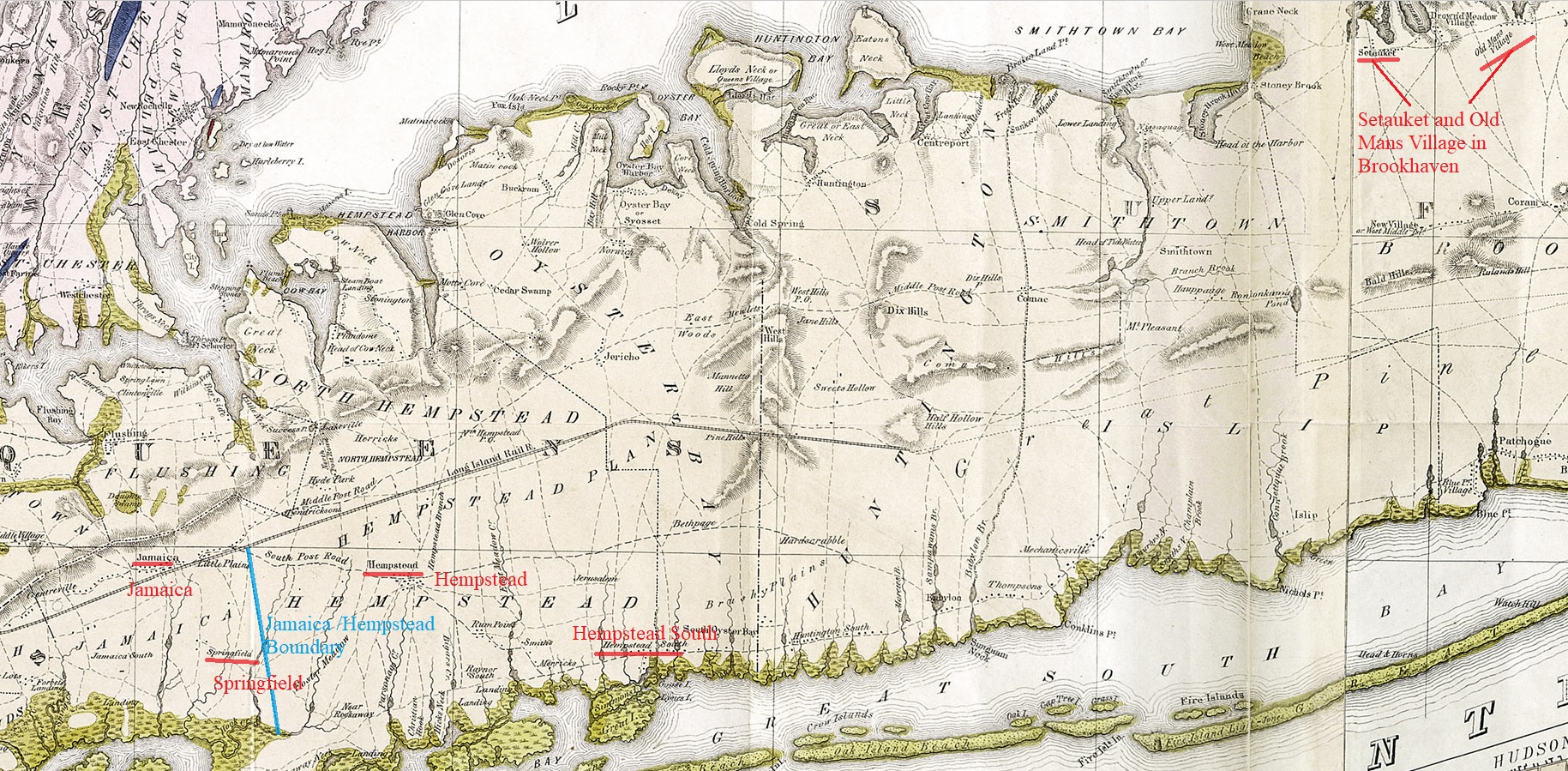
1842 Long Island map showing distances between Jamaica, Springfield, Hempstead, Brookhaven and various other places of interest
Richard Green, Joshua Pettit Final Records
There is one last record involving the man who could be Richard Green Jr. but it is known only through a cursory mention found in an old probate index. [52] According to what little information was supplied, there is a probate record for Richard Green in Queens County in will book C, page 194, dated February 23, 1764. The estate of this Richard Green was administered and/or inventoried by Increase Pettit. This record, if found, would intrinsically link the Pettit and Green families together tighter than any other record before us, save the 1725 draft deed. Unfortunately, after a diligent search, this crucial document has not been located at the time of this writing.
Also noteworthy is a 1768 Hempstead township deed between members of the Wiggins family which was witnessed by a Joshua Pettit and Timothy Rhoads.[53] A Timothy Rhodes Pettit married an Elizabeth Smith on June 30, 1818.[54] He is thought to be the son of Joshua Pettit and Sarah Skinner and great grandson of Joshua and Martha Pettit which suggests this Joshua Pettit was not the one born in 1700. The land in this deed was described as being at a neck in Hungry Harbor west of Motts Creek and west of the creek that runs out of the Great Creek. Traces of these landmarks can be found today which place it very near the Jamaica and Hempstead township lines just northeast of present-day JFK International Airport. Recall that many years earlier on January 5, 1721, a Joshua Pettit, William Carpenter and Joshua Carpenter witnessed the will of John Roods (elsewhere Roads, Rhoads) of Jamaica, a yeoman. A John Rhoads owned property adjacent to Joseph Pleas mentioned in the 1696 deed witnessed by Richard Green. There is definitely a pattern of reoccurring names tied to a specific geographic area. A connection between one or more of these families is almost inevitable but also elusive.
Other than the lost probate documents that cannot yet be positively linked to Richard Green Jr, after 1727, he and Joshua Pettit strangely vanish from the record leaving no clue as to why. Though it was not uncommon for colonists to return to England when they inherited land, there is no reason to suspect that is what happened here. It is possible one or both of them moved away, though the continued presence of children and grandchildren of Joshua Pettit south of Hempstead would suggest otherwise. Subsequent generations not only stayed in Long Island, but they did not stray far from Jamaica and Hempstead. Another fanciful story told by the Long Island Pettits placed Joshua’s great grandson Increase Pettit in the waters near Baldwin Harbor years later in 1776.[55]
Francis Pettit, son of the late John Pettit of Baldwin, tells of the role the marshes played in the Revolutionary history of his family. Franic’s father’s great-great-grandfather, Increase Pettit, while fishing with some friends down in Fundy, or Sea Dog Creek, saw a man running –running from “Redcoats”.
“We ought to save him,” exclaimed Increase. “Who’ll join me?” Nobody volunteering, Increase said, “I’ll do it.”
Jumping into his skiff, he rowed hard toward Point o’ Beach,* for which the fugitive seemed to be heading, got the man in his boat, and pulled away faster then he had come. When he got home he told that the “Redcoats” came down to the water’s edge at the Inlet, halted, took aim, but did not fire. Increase breathed a sigh of relief, then wondered why they had lowered their muskets; either he had got too far away, or the leader had decided the game was not so important after all and he would save his powder and shot.
The fugitive was named Waite –later changed to Smith. When Franics Pettit was a boy in Baldwin there lived in the village a Richard Smith. Often on his way to school Francis would be called over by Richard or his wife, Jane and be given an apple or pear. “Frankie” used to wonder what prompted this generosity –rare for them who were known as never giving anything away. It was long after he had grown to manhood that he learned that Richard Smith was a descendant of the “Waite” Smith whom Increase had saved that day long years ago at the New Inlet end of Long Beach.
*Point O’ Beach was at the tip of Long Beach just across the Inlet from Point Lookout.
This Increase Pettit story located some of the descendants of Joshua Pettit and Martha Green squarely on Hick’s Neck a few miles from Springfield south of Hempstead. Through the years the Pettit name would be fixed to various landmarks around this area known as Baldwin. “Pettit’s woods”, for example, was said to have been the location of an 1842 gathering of over 2000 Millerites who were expecting the second coming of Christ in 1843.[56] This woods was west of the intersection of Milburn and Atlantic Avenues in Baldwin, NY, not far from Parsonage Creek.[57],[58]
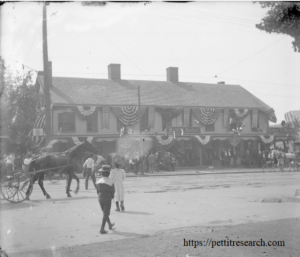
April 20, 1898. Pettit’s Hotel, Fulton St., Jamaica, NY. Owned by Alonzo B. Pettit. “The front of the hotel is draped in bunting for the celebration marking the paving of the Brooklyn-Jamaica plank road.” George Washington stayed here in 1790.
Joshua Pettit’s clan left a lasting mark on the island for many generations. His disappearance from the record after 1727 does not prove his disappearance from Jamaica. It is possible he stayed put but did not conduct any business that would require recordation in the town books. Or perhaps something tragic happened. We simply do not know. Though there are many questions that need to be answered, there is plenty of information before us and there are abundant untapped sources in New York waiting to divulge their secrets.
PART VI: CONCLUDING EVALUATION
Facts and probabilities have now been spread and entangled throughout this writing. In conclusion, we will summarize these postulations. The hope is not to set these theories in stone, but rather chisel them free for evaluation that will lead others to new research breakthroughs. With that in mind, consider these concluding reflections.
Richard Green of Barton Regis and New York City may have been the same man. Both were ropemakers by trade. Both were married to a woman named Elizabeth. Both were survived by their wife Elizabeth. In both the English draft deed and in NYC records, Elizabeth is listed as the widow of Richard Green, ropemaker. Furthermore, the NYC man was granted freeman status meaning he was the first of his family to come to America from England. It is quite possible that Richard Green of Barton Regis, England, enlisted for military service, was sent to New York City, sent for his family, and they joined him in New York and remained there for good.
The Barton Regis / NYC Richard Green was not the 1693 Richard Green of Jamaica or Brookhaven. The Barton Regis and NYC Richards left a widow named Elizabeth. The Jamaica and Brookhaven Richard was married to a woman named Hannah.
The Richard Greens in the Jamaica records and later Brookhaven records were likely the same person. Both of these Richards had a wife named Hannah. Both were cordwainers by trade. The first purchase of land by Richard Green in Brookhaven mentioned that he was from Jamaica.
The Richard Green of Jamaica/Flushing/Hempstead/Brookhaven was born in 1672 or earlier. In 1693, a Richard Green was living in Hempstead. This Richard Green would have been the legally required age to own property at the time, which was 21. This would mean he was born at least in 1672 and probably earlier.
Richard Green Jr was the only son of Elizabeth Green. This is stated as a matter of fact in the draft deed.
Martha Green was the only daughter of Elizabeth Green. This too is stated as a matter of fact in the draft deed.
Martha Green was born between 1685 and 1703. Assuming the NYC Green family was indeed the Barton Regis Green family, then the 1703 New York City census shows Richard Green Sr. with one female child in the home considered to be under 16 years of age. Supposing this was Martha Green, she would have been born between 1687 and 1703.
Joshua Pettit was born around 1700. He is listed as “age 18 or thereabouts” in the court declaration about his involvement in the Daniel Bull incident in Jamaica.
Richard Green Sr was dead by 1710. This is proven by the New York City trial of his widow, Elizabeth.
Who was the Joshua Petitt who witnessed the 1768 land deed? The 1768 land deed witnessed by a Joshua Pettit is a proverbial fly in the Pettit genealogical ointment. Had the deed been witnessed five years earlier or five years later there would be no trouble making it fit with the rest of the narrative put forward by modern researchers. However, the 1768 and 1770 dates associated with this deed call to question the feasibility of some deeply entrenched family connections. Who was this Joshua Pettit that witnessed the Wiggins deed in Queens County, NY, on April 27, 1768, and presented it to the court on May 28, 1770?
There are four possible answers to this question, to wit:
He was a 70-year-old Joshua Pettit born in 1700 and husband of Martha Green. This is possible and cannot be discounted. It is a bit odd, however, that the parties would choose a man in his 70’s to make the trip via horse from Springfield to the county courthouse to file the deed.
He was the son of Joshua Pettit and Martha Green who some say was born in 1734 and later moved to Spartanburg County, South Carolina. If Joshua and Martha Pettit had a son named Joshua Pettit Jr. and he was in New York in 1768 and 1770, then he is most certainly not the same man who moved to Spartanburg Co., SC. The Spartanburg Co., SC, Joshua Pettit’s family was in New Jersey in 1763.[59] He has been documented in Virginia as early as March 31, 1767.[60] In 1768 and 1770, he was recorded hundreds of miles away doing business in Romney, Virgina, at the same time this Joshua Pettit was doing business in Queens Co., NY.
He was the grandson of Joshua Pettit and Martha Green, the son of Increase born September 15, 1751. This is most probable but not without some complications. First, the 1751 date for this Joshua Pettit is somewhat questionable. This date was recorded for him in the journal of his nephew Ethan Pettit and seems like it might be correct when consideration is given to the other specific dates listed for family members.[61] However, an 1800 Hempstead federal census lists the only Joshua Pettit in Queens County as the head of household at 26 to 44 years old. [62] This would put his birth year between 1756-1774, not 1751. This is significant because the oldest he could have been at the time the deed was witnessed in 1768 would be 13. The court would not have accepted a deed from a 15-year-old boy when he delivered it in person two years later in 1770. However, this may very well have been an error by the census taker, in which case this Joshua Pettit is probably the man who witnessed and delivered the deed.
He was some other Joshua Pettit. This is always a possibility, but it lacks evidence.
The last thing to consider is that none of these Richard Greens were Richard Green Sr or Jr, the family from Barton Regis. This may very well be true, and it is certainly what must be presumed until proven otherwise. There are difficulties that are hard to overcome with any hypothetical association drawn between these people. When one considers the facts before us in totality, there are some anomalous issues that simply cannot be ignored. Specifically, the age gap between the various Richard Greens almost completely precludes a father/son relationship between the New York City man and the Brookhaven man. Though there are ways to make the genealogy work by putting child births on opposing ends of the childbearing years for Elizabeth and Martha, engineering a narrative in this way can be counterproductive to genealogy.
What we do know is that sometime before 1693 a Richard Greene moved to Flushing, Queens County, New York. In 1693 he was said to be a resident of Hempstead and in 1695 was identified with Jamaica. He sold his Jamaica property in 1695 and is likely the man who settled in Brookhaven, Suffolk County, New York, sometime between 1695 and 1697. He was a cordwainer who was married to a woman named Hannah. After moving, he is only found once in Queens County records as a witness in 1703 but is in numerous Brookhaven records until 1719 after which time he disappears.
Another Richard Green who was from England and was a ropemaker by trade found himself in the royal army guarding a fort at New York City in 1695. In 1702 he was granted freeman status there. He was married to a woman named Elizabeth and had at least one daughter, born between 1685-1703. He died sometime before 1710 leaving his widow Elizabeth in New York City. Elizabeth got herself in some trouble there after his death.
In 1725 the Bristol draft deed states that Richard Green Sr was dead and his widow Elizabeth Green, son Richard Green Jr, and daughter Martha Green Pettit were thought to be living in Jamaica. In 1727 a Richard Green was recorded in Springfield, Jamaica, Queens County, where he was baptized at Grace Church.
We cannot overlook the possibility that these may have been the footprints of three or more different men. Perhaps Richard Green Jr never gained sufficient socioeconomic status to find his way into the record books and perhaps Richard Green Sr never came to America.
As previously noted, even Joshua Pettit’s existence in Jamaica is only narrowly proven by a few sparce mentions in official town minutes. It does not look like he left a will, nor does it appear that he ever bought or sold any land. However, there are thousands of pages of records that have not been inspected and there are researchers willing to seek them out. Though ample data has been considered herein, the gaps in the historical record make it impossible to draw a final conclusion. Therefore, this is not the end of the genealogical study of these intriguing families, but rather just the beginning.
[Click here to download a FREE version of this book in PDF form.]
Leave a comment or ask a question here.
Footnotes:
- Michael Cooley, “Y-SNP Mutation Rates: The Pilgrim Pettit Y-DNA Project”, August 9, 2022, https://blog.ancestraldata.com/viewer.pl?2022-08-09-TPettit.html ↑
- Brandon Pettit, The Pettit Research Project, maintained by this author at https://pettitresearch.com ↑
- William Henry Pettit letter to Stephen Fletcher Pettit, Sept. 10, 1936. ↑
- Hereafter spelled “Green” in this writing unless quoting a source with a different spelling. ↑
- This story probably originated in 1939 with Herbert Furman Seversmith in his book Colonial Families of Long Island, NY and Connecticut, Vol 2. On page 543 he made the following assumption, “Susanna, [Carpenter] born at Jamaica, New York about 1699, is considered to have married Joshua Pettit of Hempstead. Issue.” In the introduction to Vol 1, Seversmith gives a defense for including speculative information in his published genealogies, and used the terms “possibly”, “probably” and “considered” to convey a reduced degree of certainty of unproven connection. Below Susanna, he lists her sibling’s marriage in a more factual manner, “Phebe, married Benjamin Cromwell”. That he “considered” Susana Carpenter to be the wife is not in question, but the author’s certainty of the connection was not without doubt. He did not intend to portray Joshua Pettit’s marriage to Susanna Carpenter as a matter of fact. This story was picked up by John S. Wurts in 1954 and retold in Magna Charta Part VII where he stated, somewhat confusingly, that Joshua married Sarah, a daughter of Increase Carpenter. ↑
- Maryland Historical Magazine. United States: Maryland Historical Society., Volume III (Maryland Historical Society, 1908), 133 ↑
- “3130. Yoseph, Strong’s Concordance”, BibleHub, accessed November 9, 2023, https://biblehub.com/hebrew/3130.htm ↑
- Kenneth Ballard Murdock, PH.D, Increase Mather, The Foremost American Puritan (Cambridge, MA: Harvard University Press, 1926) ↑
- Bristol Archives, AC/WO/12/85: Draft release, (lease missing) 1) Elizabeth Greene of the town of Jamaica, Queens County, Island of Nassaw, New York, widow of Richard Greene of Barton Regis, ropemaker, and sole heiress. ↑
- That this is a release is confirmed on page two of this document where it is stated that the parties “granted bargained and sold” the land. ↑
- Bristol Archives catalogue, “Records of the Smyth family of Ashton Court.” Accessed November 9, 2023. https://archives.bristol.gov.uk/records/AC. ↑
- Ashton Court Estate is comprised of Arts Mansion and 850 acres located at Ashton Ct, Bristol BS41 9JN, United Kingdom. ↑
- See, for example, Nicholas Pike’s 1822 version of A New and Complete System of Arithmetick Composed for the Use of the Citizens of the United States for an example of complex rate conversion between the state currencies. This does not even consider the impossibility of indexing manufactured goods whose values have changed due to technological advancement over a 300-year period. Clothing, for instance, is many magnitudes cheaper today than it was in 1725 even when adjusted for inflation. ↑
- Miller, Scott C. “Ten Facts about the Early American Economy.” George Washington’s Mount Vernon. Accessed November 9, 2023. https://www.mountvernon.org/george-washington/colonial-life-today/early-american-economics-facts/ ↑
- Anna Powell-Smith, “Open Doomsday”. Accessed November 9, 2023. https://opendomesday.org/place/ST5973/barton-regis/ ↑
- J. S. Bromley, The New Cambridge Modern History: Volume 6, The Rise of Great Britain and Russia, 1688-1715/25. (United Kingdom: Cambridge University Press, 1970.) 69. ↑
- Queens County, New York, Deeds Lib B1: 238; (film #1414478); Richard Rhoades to Richard Greene; October 23, 1693; ↑
- Queens County, New York, Deeds Lib B1: 237; (film #1414478); Waite Smith and Phebe Smith to John Talman; June 23, 1694; ↑
- Queens County, New York, Deeds Lib B1: 267; (film #1414478); James Harde to John Esmond; March 11, 1695; ↑
- Today known as Little Neck Bay ↑
- Josephine C. Frost, Records of the town of Jamaica, Long Island, New York, 1656-1751 Volume I (Brooklyn, NY: The Long Island Historical Society, 1914), 423-424 ↑
- Queens County, New York, Deeds Lib B2: 61-2; (film #1414478);Richard Green to Daniel Whitehead; December 20, 1695; ↑
- New York Board of Assessors, Collections of The New York Historical Society for the Year 1910 (New York: Printed for the Society, 1911) 28,44,80,103,182. ↑
- Josephine C. Frost, Records of the town of Jamaica, Long Island, New York, 1656-1751 Volume II (Brooklyn, NY: The Long Island Historical Society, 1914), 240-241 ↑
- “Ship’s Passenger Lists Increase 1635,” Olive Tree Genealogy, accessed November 9, 2023, http://www.olivetreegenealogy.com/ships/increase1635.shtml ↑
- The location of this colonial town should not be confused with the modern-day hamlet of the same name in the same county. The Brookhaven town of the colonial period was centered around the place known as “Setauket” which is situated off of Setauket Harbor. ↑
- Suffolk County, New York, Deeds Vol A: 80; John Burnat & Richard Green; May 29, 1696; ↑
- Queens County, New York, Deeds Lib B1: 321; (film #1414478); William Nicoll, Andrew Gibb to Samuell Mills; May 25, 1697; ↑
- William S. Pelletreau, Early Long Island Wills of Suffolk County 1691-1703 (New York: Franics P. Harper, 1897; Reprinted Salem, Massachusetts: Higginson Book Company), 174 ↑
- Queens County, New York, Deeds Lib B1: 411; (film #1414478); William Creed and Sarah Creed to Doctor Robert Read; October 2, 1699; ↑
- New York Historical Society, Collections of the New York Historical Society for the Year 1885 (New York: Printed for the Society, 1886) 82 ↑
- A Fort William Henry in Lake George, New York was constructed in 1755 and should not be confused with the fort referred to in this document. This document describes the fort as being “within this city [New York City].” In addition to Fort Amsterdam, it was also called Fort James, Fort Willem Hendrick, Fort Anne and Fort George. ↑
- Edmund Bailey O’Callaghan, The Documentary History of the State of New-York: Volume I (Albany, NY: Weed, Parsons & Co., Public Printers, 1850), 403 ↑
- John Cox, Jr. Oyster Bay Town Records, Volume II, 1691-1704 (New York: Tobias A. Wright, 1924) 610 ↑
- Grantor Index for Suffolk County deeds 1660-1950, Suffolk County Clerk, Suffolk Co., NY. (This index references Suffolk County deed Liber 25, page 191, which appears to be current missing) ↑
- Suffolk County, New York, Deeds Vol A:163, Abraham Hawke to Richard Green, May 14, 1709 (Registered Oct 26, 1709); Suffolk County Clerk. ↑
- Kenneth Scott, New York City court records, 1684-1760 : Genealogical Data from the Court of Quarter Sessions (Washington, DC: National Genealogical Society, 1982), 25 ↑
- John E. Glover, Town Clerk, Records of the Town of Brookhaven Book B 1679-1756 (New York: The Derrydale Press, 1932) 513 ↑
- Ibid. 345 ↑
- Ibid. 368-369 ↑
- Ibid. 354-355 ↑
- Philipp A. Hattermer, Town Clerk, Records of the Town of Brookhaven Book C 1687-1789 (New York: The Derrydale Press, 1931) 149 ↑
- John E. Glover, Town Clerk, Records of the Town of Brookhaven Book B 1679-1756 (New York: The Derrydale Press, 1932) 356-357 ↑
- Edmund Baily O’Callaghan, The Documentary History of the State of New York Volume III (Albany, New York: Weed, Parsons & Co., Public Printers, 1850) 176 ↑
- Ibid. 388-389 ↑
- John E. Glover, Town Clerk, Records of the Town of Brookhaven Book B 1679-1756 (New York: The Derrydale Press, 1932) 374-375 ↑
- William Applebie Eardeley, Records in the Office of the County Clerk at Jamaica, Long Island, New York 1680-1781. Wills and Administrations Guardians and inventories, Volume I (Brooklyn, New York: 1918), 45 ↑
- Horatio Oliver Ladd, The Origin and History of Grace Church Jamaica, New York (New York: The Shakespeare Press, 1914) 275 ↑
- Ethan Pettit diaries, MS 0180, University of Utah Libraries Special Collections, J. Willard Marriott Library, University of Utah, Salt Lake City, UT ↑
- Josephine C. Frost, Records of the town of Jamaica, Long Island, New York, 1656-1751 Volume III (Brooklyn, NY: The Long Island Historical Society, 1914), 266 ↑
- Ibid. 267-269 ↑
- William Applebie Eardeley, Records in the Office of the County Clerk at Jamaica, Long Island, New York 1680-1781. Wills and Administrations Guardians and inventories, Volume I (Brooklyn, New York: 1918), 8, 11 ↑
- Benjamin D. Hicks, Towns of North and South Hempstead, Long Island, N.Y., Volume V (Jamaica, N.Y.: Long Island Farmer Print, 1904) 282-284 ↑
- Richard Henry Greene, The New York Genealogical and Biographical Record, Volume 53 (New York, NY: New York Genealogical and Biographical Society, 1922) 243 ↑
- Works Projects Administration, Hick’s Neck, The Story of Baldwin, Long Island (Baldwin, Long Island, New York: The Baldwin Citizen Press, 1939) 21 ↑
- Ibid. 36 ↑
- Ibid. 43 ↑
- Pettit Woods would be located in the vicinity of 1000 Atlantic Ave, Baldwin, NY, today. ↑
- Revolutionary War Pension and Bounty-Land Warrant Application Files, Henry Pettit #W5528, National Archives Microfilm Publication M804, National Archives and Records Administration (NARA), Washington D.C. ↑
- Peter Steenbergen, Ledger for Inn at Romney, Virginia, A&M 2337, West Virginia and Regional History Center, West Virginia University, 1549 University Avenue, P.O. Box 6069, Morgantown, WV 26506-6069 ↑
- Ethan Pettit diaries, MS 0180, University of Utah Libraries, Special Collections, J. Willard Marriott Library, University of Utah, Salt Lake City, UT ↑
- 1800 United States Census, South Hempstead, Queens County, New York, digital image of original, “Joshua Pettit,” familysearch.org ↑
